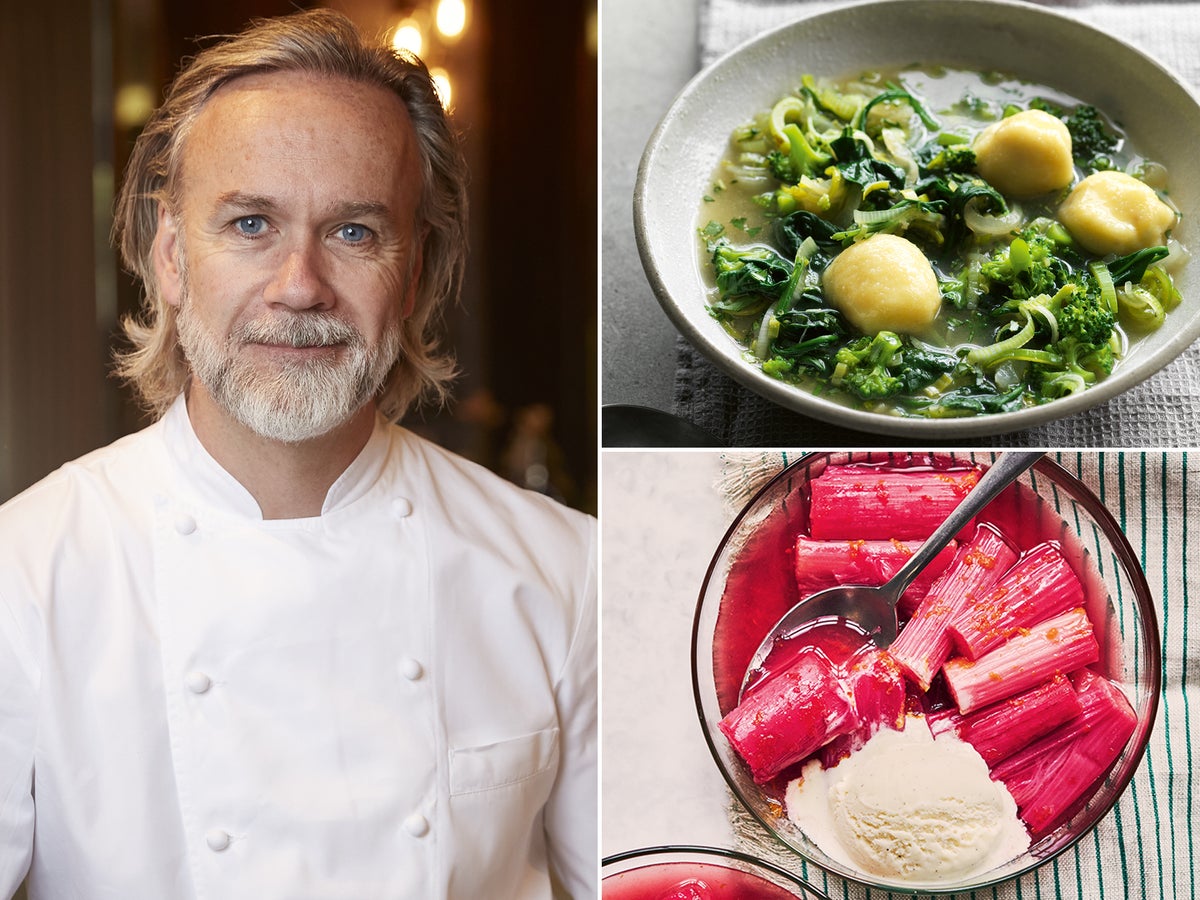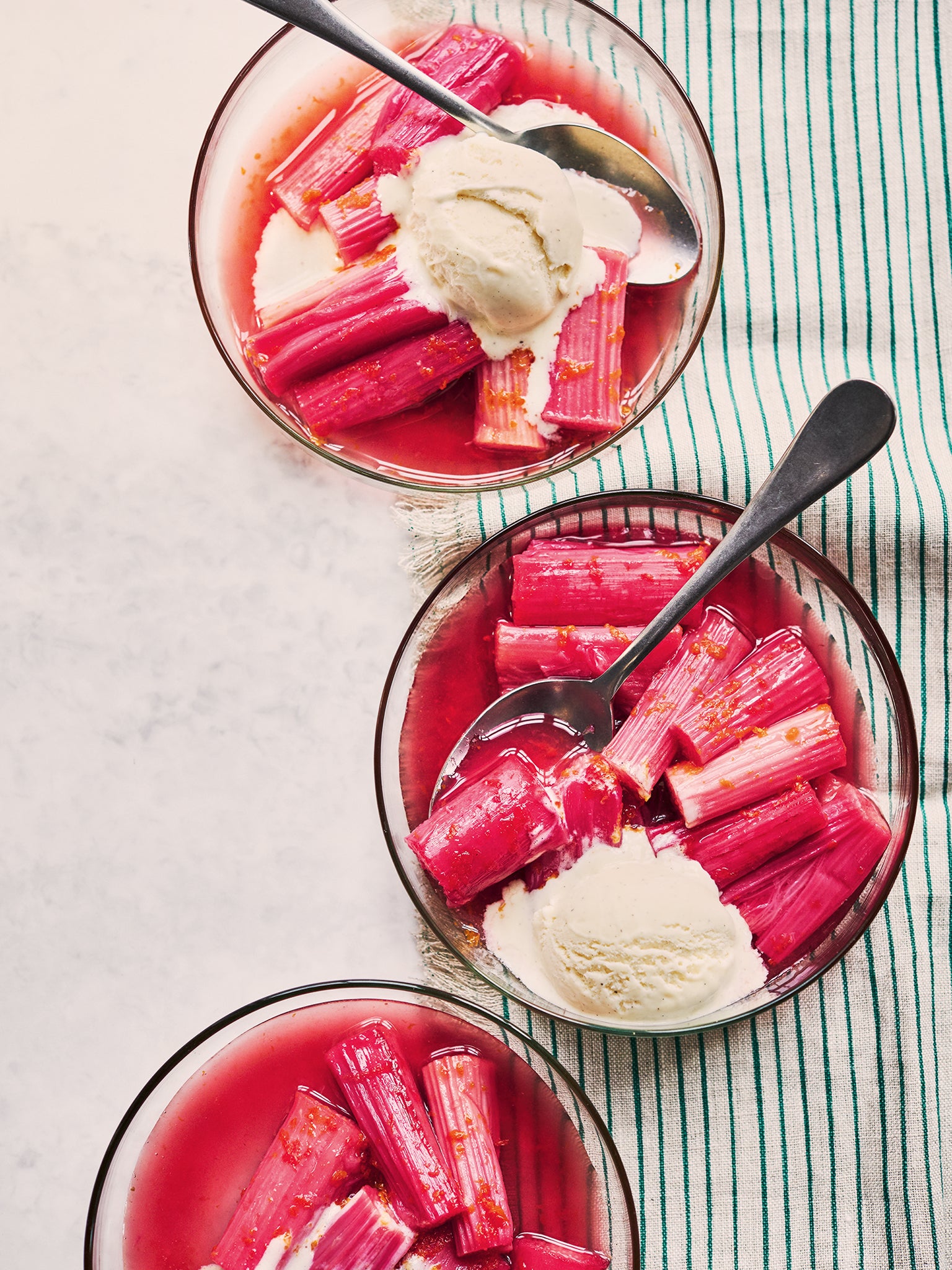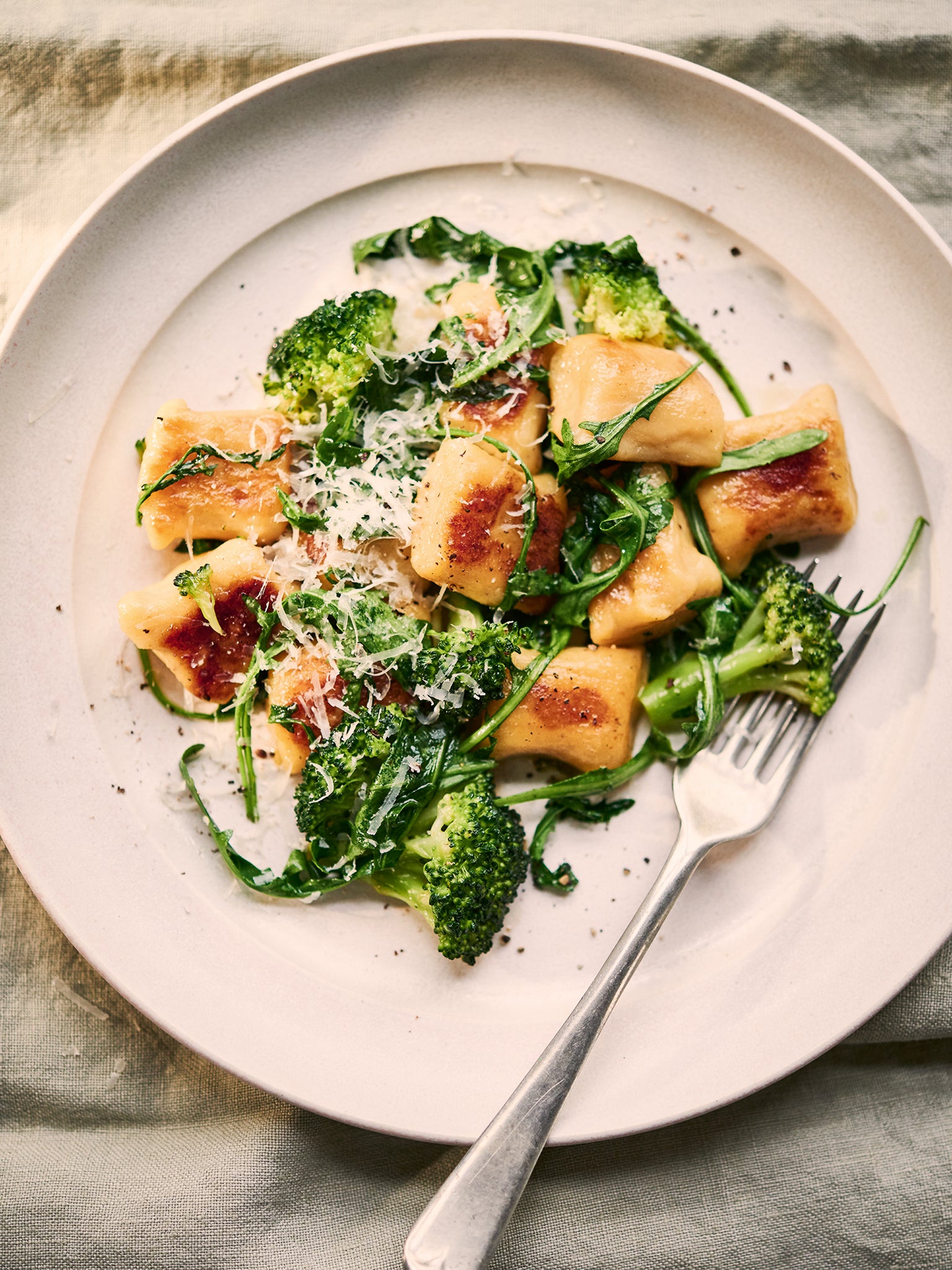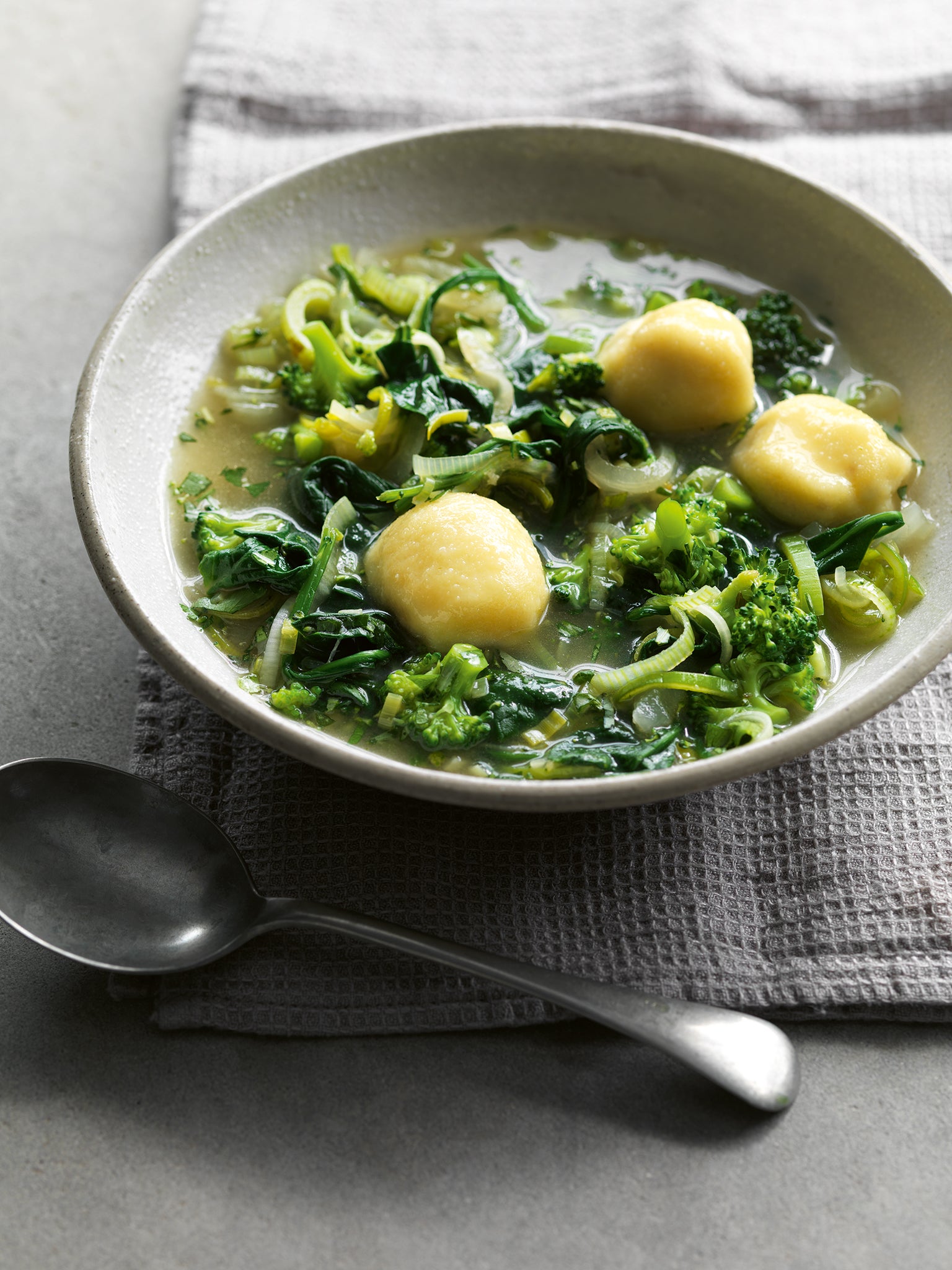
It’s not all doom and gloom: the nights are getting lighter, the sun is getting warmer and spring is on the horizon. With it comes a wealth of new season produce and possibilities for fresh adventures in the kitchen.
Here’s just a few recipe suggestions for what to cook in March and beyond.
Early season rhubarb is a perfect partner for ginger in the baked dessert below, which is a simple but colourful start to the season’s eatings.
Spring lamb can’t be missed, but opting for cheaper cuts like the belly won’t compromise on flavour. Rosemary and malt-glazed lamb belly (also known as lamb breast) with salsa verde would be delicious with couscous or parmentier potatoes, or even in wraps with salad and the spicy green sauce drizzled over the top. Don’t be put off by the anchovies in the sauce, they add a great depth of flavour.
The sauteed potato gnocchi with broccoli, rocket and parmesan is a great meat-free dish for midweek and the perfect “fits all” option when feeding vegetarian friends and you want a dish everyone can eat.
Lastly, my spin on a classic vegetable soup, made “super green” and with ricotta dumplings, is a great vehicle for any other vegetables you have in your fridge – the more the merrier.
Baked rhubarb with ginger and orange

Serves: 4
Prep time: 10 minutes | Cooking time: 20-25 minutes
This recipe features young, early-season rhubarb which has slimmer stems and is less tough than later season rhubarb. Rhubarb and ginger are perfect partners – the slight heat from the ginger complements the sharp rhubarb – and the orange brings sweetness to the dish. Serve with custard and shortbread biscuits, or just some creme fraiche.
Ingredients:
500g young rhubarb, cut into 5cm batons
Grated zest and juice of 1 orange
75g caster sugar
2 pieces of stem ginger, thinly sliced
1 tbsp stem ginger syrup
Vanilla ice cream, to serve
Method:
1. Preheat the oven to 130C/110C fan/gas ¾.
2. Put the rhubarb in a casserole dish along with the rest of the ingredients and coat the rhubarb in the syrup mixture, making sure the rhubarb is spread out evenly.
3. Cover the dish with foil and bake in the oven for 20-25 minutes, until the rhubarb is soft to touch but still holds its shape – how long this will take depends on the thickness of the rhubarb. Remove from the oven and allow to cool a little.
4. Serve while still slightly warm.
Rosemary and malt-glazed lamb belly with salsa verde
Serves: 6
Prep time: 15 minutes | Cooking time: 2 hours 20 minutes
In the past, cuts like lamb belly were known as “the butcher’s cut”, cuts taken home by the butcher as they were cheap and didn’t sell. Lamb belly, also known as lamb breast, is still not a particularly common cut, but restaurants have begun to make it fashionable and it makes a great sharing meal as everyone gets to pull some meat from the belly on the serving plate. Don’t be put off by the anchovies in the sauce, they add a great depth of flavour and can’t even be seen when the sauce is whizzed up. This would be delicious with couscous or parmentier potatoes, or even in wraps with salad and the salsa verde drizzled over.
Ingredients:
2 lamb breasts (bone in)
About 100ml olive oil
2 garlic cloves, skin on and smashed
2 sprigs of rosemary
Sea salt
For the malt glaze:
200ml malt vinegar
2 tbsp malt syrup
100g soft light or dark brown sugar
1 tbsp freshly chopped rosemary
For the salsa verde:
1 bunch of flat-leaf parsley
½ bunch of mint
Leaves from 1 sprig of rosemary
15g capers
30g tinned anchovies
1 garlic clove, peeled
Grated zest and juice of 1 lemon
1 slice of white bread, crusts removed
150ml extra virgin rapeseed oil
Get ahead:
Cook the lamb belly and make the salsa verde several hours in advance, then reheat the meat when you want it. Leave the slow-cooked lamb on the side after its 2 hours of cooking, covered in its tray, then put in a hot oven and follow the glazing steps above as it comes back to temperature before serving.
Variation:
Swap the lamb belly for lamb shoulder, which is a little less fatty than the belly
Method:
1. Preheat the oven to 160C/140C fan/gas 3.
2. Place the lamb in a large roasting tray, season generously with salt and rub in the oil followed by the garlic and rosemary. Cover with foil and cook in the oven for 2 hours. Once cooked, you should be able to pull the meat away from the bone.
3. While the lamb is cooking, prepare the malt glaze. Combine all the ingredients in the saucepan, then bring to a boil over medium heat and cook for 8-10 minutes until reduced to a syrupy consistency.
4. Once the lamb has been cooking for 2 hours, remove it from the oven and increase the temperature to 190C/170C fan/gas 5. Remove the foil and glaze the meat with one-third of the malt syrup using a pastry brush. Return to the oven for 5 minutes until the glaze starts to lightly caramelise and become golden, then remove from the oven and repeat this process twice more using the remaining glaze. After the final glaze the lamb belly should be sticky and caramelised with the malt syrup.
5. Allow to rest for 10 minutes before serving.
6. To make the salsa verde, put all the ingredients in a food processor and blitz until smooth. Adjust the seasoning if required.
7. Serve the rested lamb belly with the salsa verde, family style, letting everyone help themselves to the piece they like It doesn't need to be carved, the meat will be very tender and will just pull apart.
Sauteed potato gnocchi with broccoli, rocket and parmesan

Serves: 4
Prep time: 30 minutes | Cooking time: 55 minutes
This is a great meat-free dish for midweek and the perfect “fits all” option when feeding vegetarian friends and you want a dish everyone can eat.
Ingredients:
2 tbsp vegetable oil, plus extra for drizzling
100g unsalted butter
1 head of broccoli, cut into small florets
100ml good quality vegetable stock
100g rocket
50g parmesan, finely grated
Nutmeg, for grating
Sea salt and freshly ground black pepper
For the gnocchi:
2 large red-skinned potatoes (about 655g total weight)
100g plain flour, plus extra for dusting
2 large egg yolks
Get ahead:
Cook the gnocchi, then cool, spread over an oiled tray, and drizzle with oil to stop them sticking together. Cover with oiled clingfilm and chill for up to 24 hours. Cook from room temperature. Freeze the uncooked gnocchi on a tray lined with baking parchment. Once solid, transfer to a freezable container and freeze for up to one month. Cook from frozen in boiling water for 2-3 minutes (don’t thaw, or they’ll stick together).
Variations:
For a quick supper, serve the cooked gnocchi with a simple, smooth tomato sauce and some chopped basil. Or simply top the cooked gnocchi with extra virgin olive oil, grated parmesan and toasted pine nuts.
Method:
1. First, make the gnocchi. Put the whole unpeeled potatoes in a saucepan and cover with cold water. Add a pinch of salt, place over medium heat and bring to the boil. When it starts to boil, lower the heat and simmer for 35-45 minutes until the potatoes are soft when pierced with a knife. Drain and steam dry for 5 minutes. While still hot, peel the skin then push the flesh through a potato ricer into a large mixing bowl (or press them through a fine metal sieve using the back of a large kitchen spoon). Mix the flour, egg yolks and ¾ teaspoon of salt into the potato until the mixture comes together as a dough.
2. Transfer the dough to a floured work surface and divide into four pieces about 150g each. Using both hands, roll each into a long sausage about 38cm long and 2cm in diameter, then cut into 2.5cm pieces. You should have 15 pieces per sausage.
3. Bring a saucepan of water to the boil over medium heat, then poach the gnocchi in batches; once they rise to the surface, let them cook for 1 minute. They will look like little parcels. After 1 minute, use a slotted spoon to transfer the gnocchi to an oiled tray in a single layer. Leave to cool. You can drizzle the gnocchi with oil to prevent them drying out and sticking together.
4. Once all the gnocchi is cooked, heat the oil in a large saute pan over high heat. Cook the gnocchi for 1-2 minutes on each side until golden. Once coloured, melt the butter in the pan, when it begins to foam, add the broccoli and stock with a pinch of salt. Cover with a lid and steam the broccoli for 2 minutes, then remove the lid, stir through the rocket and allow it to wilt. Remove from the heat and finish the gnocchi with the grated parmesan, pepper and a grating of nutmeg before serving.
Super green soup with ricotta dumplings

Serves: 4
Prep time: 20 minutes, plus 1 hour chilling | Cooking time: Around 40 minutes
This is my spin on a classic vegetable soup. You can add any other vegetables you have in your fridge – the more the merrier. The dumplings are very easy to make and can also be used to serve with pasta and homemade tomato sauce.
Ingredients:
2 tbsp vegetable oil, plus extra for greasing
1 onion, sliced
2 bay leaves
½ tsp table salt
800ml-1L vegetable stock
1 leek, finely sliced (white part only)
1 broccoli head, finely chopped
100g baby spinach leaves
1 tbsp finely chopped tarragon
1 tbsp finely chopped flat leaf parsley
Extra virgin olive oil, for drizzling
Sea salt and freshly ground black pepper
For the ricotta dumplings:
240g ricotta
Grated zest of ½ lemon
4 tbsp semolina
Method:
To make the ricotta dumplings, beat the ricotta in a bowl with the lemon zest and a pinch of sea salt and pepper. Roll the mixture into 16 balls then roll the balls in the semolina until thoroughly coated. Transfer to a plate and chill for 1 hour to firm up.
Heat two tablespoons of vegetable oil in a large saucepan over medium heat. Add the onion, bay leaves and table salt. Cook for 7-10 minutes until the onion is soft but not coloured. Add the vegetable stock and simmer gently for 20 minutes.
While the stock is simmering, cook the dumplings. Lightly grease a steamer with oil and arrange the ricotta dumplings inside. Set the steamer above a pan of simmering water, cover and steam for five minutes (you may need to do this in batches, depending on the size of your steamer).
Remove the bay leaves from the saucepan and add the leek. Simmer for five minutes and then add the broccoli. Simmer for three minutes then finish with the spinach leaves and chopped herbs. Taste and adjust seasoning if necessary.
Add a few dumplings to each bowl of soup, sprinkle with black pepper and finish with a drizzle of olive oil.
Marcus Kitchen, published by Harper Collins, is available now.




!["[T]he First and Fifth Amendments Require ICE to Provide Information About the Whereabouts of a Detained Person"](https://images.inkl.com/s3/publisher/cover/212/reason-cover.png?w=600)


